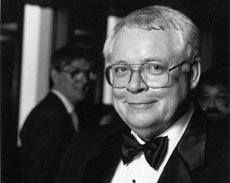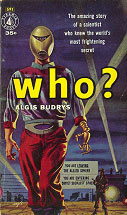Tim Powers on Who?
In the April 1955 issue of Fantastic Universe magazine appeared a story called "Who?" by Algis Budrys. (Also in that issue was a story by "John A. Sentry," a Budrys pseudonym.) On the magazine's cover is Kelly Freas's iconic painting of the protagonist of "Who?"––a man smoking a cigarette who appears to be glowering at the viewer, though his head is a steel egg with the eyes hidden in a horizontal slot. (Freas said that he used a big spoon to get the gleams and reflections right.) The story is scarcely ten pages long.
Many writers have made novels from previously published short pieces, either incorporating the short piece into a bigger story or simply inflating it to novel length. Budrys did neither; the short story "Who?"––whether Budrys intended it that way or not––is a preliminary sketch for the eventual 1957 novel of the same name.
The short story takes place, perfunctorily, on the moon, but the core puzzle of the novel is already the main issue––how to decide whether a man with no identifiable features is a top-clearance western scientist artificially rebuilt beyond recognition after massive injuries, or a Soviet spy pretending to be the scientist. In the short story, the puzzle is cleverly but fairly easily solved. Probably only Budrys himself saw in it the scope and depth of the novel of the same title that was to be published three years later.
The novel is set on Earth, Budrys having apparently realized that the moon location was a needlessly distracting element for the story he wanted to tell. The first scene takes place at the border between the Allied Sphere and the Soviet Socialist Sphere—apparently in Munich—and in its gritty, tense realism, it recalls the opening of John LeCarré's The Spy Who Came in from the Cold, which was published five years later.
And, in the context of a science fictional future world, Budrys presents a picture of Cold War politics and espionage that is surprisingly insightful for an American writer of the time—but in many ways Budrys was never precisely an American writer. He was born in East Prussia, and his father—on whom he based the Soviet Colonel Anastas Azarin in Who?—was a Lithuanian diplomat. It's an affectionate portrait. Budrys has said, "A lot of my life when I was a small child was spent in cars, or trains, talking to strangers, speaking a variety of languages, never settling down anywhere . . ."
That landless quality, which Budrys never entirely lost, is certainly the core of the complex, contradictory but fully realized character of Martino. The novel is an espionage thriller written by a man with a singularly international perspective, but, more than that, it is a deeply affecting portrait of a man deprived of his identity. And only a science-fiction context could provide plausible circumstances—Martino's reconstructive conversion into a nuclear-powered semi-robot––for that drastic deprivation.
Budrys does not present the story's events in chronological order, and there are frequent shifts in point-of-view, but the narrative is handled so skillfully––one is tempted to say effortlessly––that the reader follows the shifts without any confusion. Following the return of the Martino figure to the Western sector, we're given extensive flashbacks of Martino's earlier life, interspersed with scenes of his grotesque return to New York from Soviet captivity. The Western authorities, uncertain whether it's the real Martino inside the steel prosthetic shell or a well-coached Soviet spy, follow his every move (at one point the reader needs to know that the Italian word for "German" is "tedesco"), and it's through their suspicious eyes that we watch the Martino figure try to establish contact with Martino's past life.
We see him try, and ultimately fail, to establish that contact. We see that, as with all tragedies, the failure was inevitable from the start.
Algis Budrys was one of the handful of literary geniuses who have found that science fiction is the field most open to the exploration of their deepest personal convictions; and in Who? he produced a transcendent novel which could only have been written from his unique perspective—and a human tragedy that could only have been written as science fiction.

Algis Budrys

Tim Powers on Who?
Read Biography
Algis Budrys—“Who?” The Original Short Story
Like more than a few of the 1950s’ classic science fiction novels, Algis Budrys’s Who? began as a short story. He wrote it––he later claimed––having been inspired by a Kelly Freas painting he had seen in the offices of Fantastic Universe, and published it in that magazine in April 1955. Here is the original “Who?”A Conversation with Algis Budrys
Algis Budrys discusses his novel Who?, along with many other subjects, in this interview with Darrell Schweitzer published in Amazing Stories in November 1981.Audio: Algis Budrys—“Protective Mimicry” on X Minus One (1956)
Other Novels by Algis Budrys






